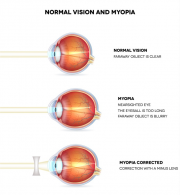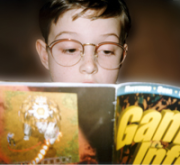Contents |
What is Myopia? What Causes it?
Introduction
Myopia is a refractive error also known as nearsightedness or shortsightedness. (Refractive errors are named for where the uncorrected vision is better; in this case, nearsightedness gives good vision up close, but blurriness for things in the distance.)
In an eye that is myopic, light rays entering the eye are brought to a focus in front of the retina instead of exactly on it, so images are blurry instead of being sharp and clear. When the myopic person gazes at something nearby, it is already in focus, so it is clear.
Most people thing of myopia as a condition where the person has “weak” eyes, but actually the eyes are stronger than they should be; the eye has too much power for its length, not too little.
Knowing some terms will be helpful in understanding myopia, as well as other refractive errors. Eyecare practitioners do testing and diagnose refractive errors at specific standardized distances, and use standardized language to describe vision and related ideas.
- Visual acuity is a measurement of the clarity of objects or letters, at specific distances from the eyes. Unless specified, visual acuities are meant to describe the vision without corrective lenses at 20 feet away from the eyes.
A person with 20/20 vision sees letters of the same size and at the same distance as most other people; however, 20/40 vision means that letters seen by most people at a distance of 40 feet, must be only 20 feet away for the tested person to see. The top number in the equation indicates the distance where he can see the letters, and the bottom number is how far away most other people can see the same size letters.
It is possible to have better than 20/20 vision, too. If the person being tested can see letters at 20 feet that most others would need to bring to 15 feet, then he can be said to have visual acuity of 20/15.
- Near vision is tested at 16 inches or 40 cm from the eyes. Eyecare practitioners may refer to vision “at near” or “nearpoint,” or other similar terms. In young children, “near” usually means only 12 to 14 inches, because children hold things closer than adults just due to their smaller size.
- Distance vision is tested at 20 feet and may be referred to as “at distance” “at far,” “farpoint” or other similar terms. For purposes of vision testing, anything at 20 feet or beyond is considered as “distance.”
- Uncorrected vision describes the quality of the image without any eyewear in place at distance. Thus, when eyecare practitioners discuss myopia, they refer to the amount of lens power needed to make the vision clear at farpoint. For example, a 5-diopter myope needs a minus-5.00 lens to see 20/20 letters at 20 feet.
- Nearpoint stress is a term used to describe the act of making near tasks clear by using the focusing system musculature inside the eye. When a person looks from distance to near, the muscles go to work automatically to change the shape of the inner lens. In other words, the focusing muscles accommodate themselves to the near demand. When the demand for near clarity continues over time, the focusing system can become stiff and unresponsive, due to nearpoint stress.
Myopia is one of the two most common refractive errors, globally; it has been estimated that up to half the population may be nearsighted. Research has given us two major theories about what causes it, and both have validity in different ways. Perhaps it may be helpful to consider myopia as the result of both possible causes.
Nature versus Nurture
One hypothesis regarding the origin of myopia is that it is hereditary. This is confirmed by the high percentage of people with myopia whose parents were also myopic; there is definitely evidence of a genetic factor.
However, there is also evidence that myopia may be caused by prolonged reading or focusing on other near tasks, a result of the eyes accommodating to the demands of nearpoint stress.
Evidence for the latter theory can be seen in worldwide statistical analysis. For example, even 30 years ago, the incidence of myopia in Singapore was about 25%, while now it is as high as 80%. The only factor that has significantly changed is the percentage of the population who are being educated and who go on to college and graduate degrees. In areas where higher education is not pursued by most, the incidence of myopia is much less.
Further, myopia seems to follow the geographical locations of nations where scholastic success is highly valued (Canada, the US, Japan, Europe). Not only is there a high incidence of myopia but the amount of myopia that an individual will develop is higher also. This may be because myopia also begins to show up at an earlier age.
Reading, studying, computer use and video games are all activities that require prolonged focusing at near. While the “nature” part of this equation indicates that there is certainly a genetic factor at work, the children of myopic parents tend to become myopic themselves. The “nurture,” part seems significant too, because when children spend hours each day focusing on near targets like books and computer screens, they also tend to develop myopia even if both parents have perfect vision.
In our society, scholastic success is expected and rewarded, but such success often causes nearpoint stress; the visual system will eventually begin to adapt by leaving the eyes in focus at that near distance. Distance vision becomes blurred, but nearpoint stress decreases.
Prevention
Can we prevent myopia? Perhaps this may be possible, at least to some extent. We know that myopia is caused in some cases by heredity, but is it possible that nearpoint stress may trigger its onset?
If the near tasks that we do as children can actually cause the eye to become longer, it might be possible to intervene pharmaceutically to prevent it from developing.
Another method of relieving nearpoint stress is with low-powered focusing lenses, which act as “helpers” to reduce the amount of focusing that the system must do; it may be possible to intervene and break up the adaptation that begins to occur, and thus prevent the myopia from developing.
Conclusions
There are many worse things in life that can happen than to develop myopia; perhaps being myopic actually helps us succeed academically by reducing the amount of focusing demand while we do our homework or play games at the computer.
Research continues in this area, which obviously has both genetic and environmental factors. Meanwhile, technology has given us the means to sidestep the effects of myopia with ophthalmic lenses, terrific frames, amazing contact lens materials and designs, ways to reshape the cornea with ortho-keratology, and even refractive surgery.
Reading is a wonderful use of time, and computer games have been shown by various research studies to be beneficial to develop better hand-eye coordination and contribute to more connections between the neurons in the brain, which is one factor in what we call intelligence. We should not discourage children or adults from reading, because it is too important. If the price is the development of myopia, it’s not very expensive.







